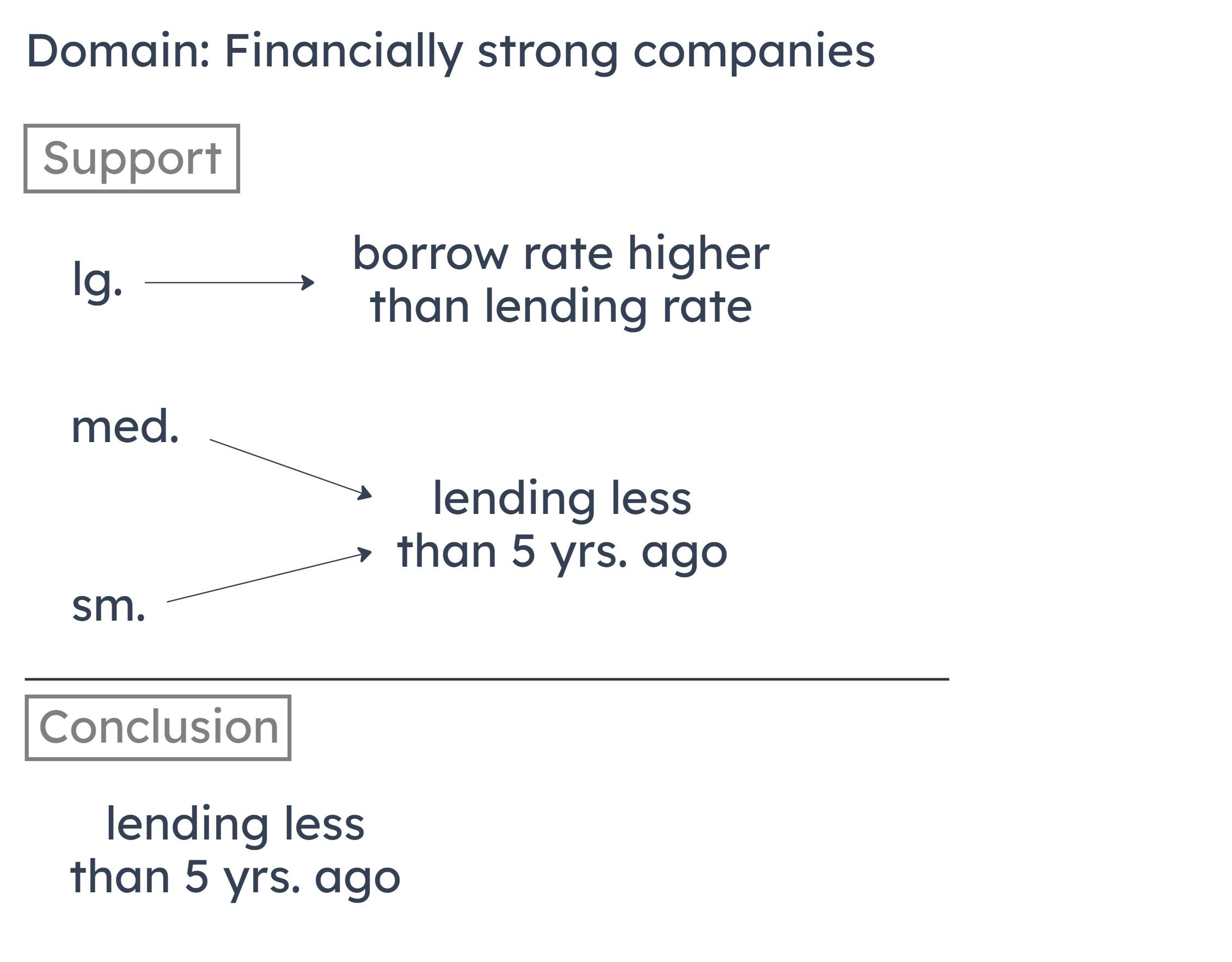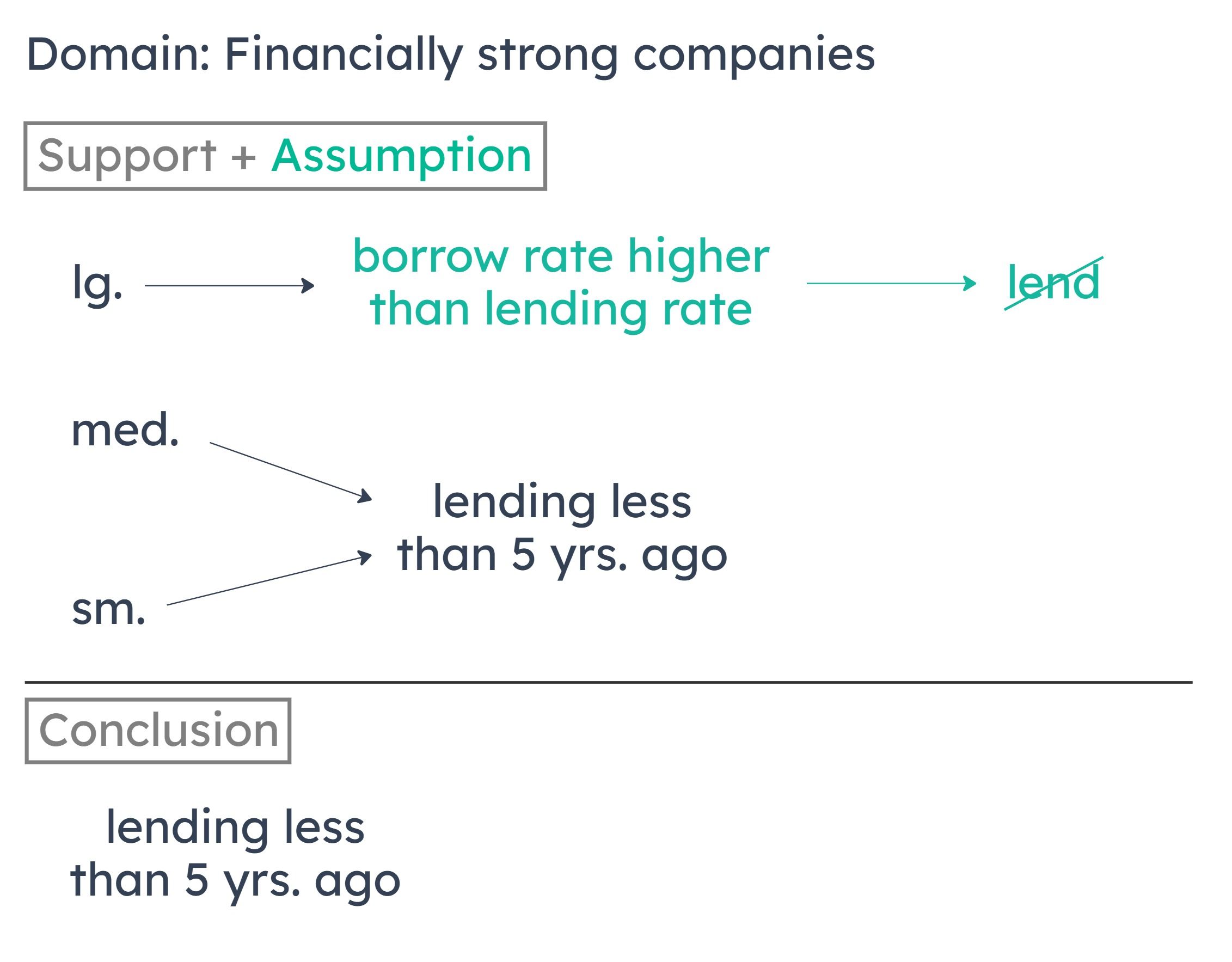For large, financially strong companies, the current interest rates that banks pay to borrow are higher than the interest rates they can receive for loans to these companies.
Banks won’t lend to companies that are not financially strong.
Total lending by banks to small and medium companies is less today than it was five years ago.
Banks

So to make the argument valid, we want to learn that lending to large, financially strong companies has NOT increased enough to outweigh the decrease in lending to small/medium companies. The correct answer might interact with the first premise concerning interest rates for borrowing vs. lending concerning large companies. The role of that premise is not entirely clear right now.
A
Banks will not lend money at interest rates that are lower than the interest rates they pay to borrow.

B
Most small and medium-sized companies were financially stronger five years ago than they are now.
C
Five years ago, some banks would lend to companies that were not financially strong.
D
The interest rates that banks currently pay to borrow are higher than the rates they paid five years ago.
E
The interest rates that small and medium-sized companies pay to borrow are higher than those paid by large, financially strong companies.
A
A few of the most authoritative scientific journals were among the first to offer full online access to their articles.
B
Scientists who wrote a lot of articles were the most enthusiastic about accessing journal articles online.
C
Scientists are more likely to cite articles by scientists that they know than they are to cite articles by scientists they have never met, even if the latter are more prominent.
D
Several new scientific journals appeared at roughly the same time that full online access to scientific articles became commonplace.
E
Online searching made it easier for scientists to identify the articles that present the most highly regarded views on an issue, which they prefer to cite.
A
Conditions on Venus make it unlikely that any instrument targeting Venus would detect a volcanic eruption directly.
B
Evidence suggests that there was a short-term spike in sulfur dioxide in Venus’s atmosphere 30 years earlier.
C
Levels of sulfur dioxide have been higher in Venus’s atmosphere than in Earth’s atmosphere over the long term.
D
Traces of the sulfur dioxide from volcanic eruptions on Earth are detectable in the atmosphere years after the eruptions take place.
E
Most instances of sulfur dioxide spikes in the Earth’s atmosphere are caused by the burning of fossil fuels.
All the apartments on 20th Avenue are in old houses. However, there are twice as many apartments on 20th Avenue as there are old houses. Therefore, most old houses on 20th Avenue contain more than one apartment.
Summarize Argument
The author concludes that most old houses on 20th Avenue contain more than one apartment. He supports this by saying that all the apartments are in old houses, and there are twice as many apartments as old houses.
Identify and Describe Flaw
The author concludes that most— i.e. more than half— of the old houses have more than one apartment, just because there are twice as many apartments as old houses. But let’s say there are 10 old houses and 20 apartments. What if one old house contains all 20 apartments? What if 4 old houses contain 5 apartments?
It’s not necessarily true that most of the old houses contain more than one apartment. In fact, it’s possible that most of the old houses don’t contain any apartments at all!
A
overlooks the possibility that some of the buildings on 20th Avenue are not old houses
The author doesn't overlook this possibility. He says that there are twice as many apartments as old houses and that all the apartments are in old houses. But there might still be other buildings that are not old houses.
B
draws a conclusion that simply restates one of the premises offered in support of the conclusion
This is the cookie-cutter flaw of circular reasoning, where the conclusion is simply a restatement of one of the premises. The author doesn’t make this mistake. His premises may not support his conclusion well, but they are distinct from his conclusion.
C
fails to consider the possibility that some buildings on 20th Avenue may offer types of rental accommodation other than apartments
The author doesn’t overlook this possibility. His argument is only about the old houses and apartments on 20th Ave. There might be some buildings that are hotels or rental houses, but this doesn’t affect his argument.
D
confuses a condition whose presence would be sufficient to ensure the truth of the argument’s conclusion with a condition whose presence is required in order for the conclusion to be true
This is the cookie-cutter flaw of confusing necessary and sufficient conditions. The author doesn’t make this mistake; he never presents a condition sufficient to ensure the truth of the conclusion in the first place.
E
fails to address the possibility that a significant number of old houses on 20th Avenue contain three or more apartments
If a significant number of old houses have 3 or more apartments, the author can't conclude that most houses have at least one. For example, if there are 10 old houses and 20 apartments, it's possible that just 4 houses have 5 apartments, meaning most houses have no apartments.